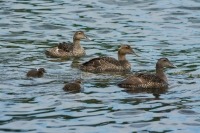
(Photo: Nick Hawkins)
Eider Duck
Somateria mollissima
The common eider weighs 850 grams to 3025 grams, making it the largest duck species in the northern hemisphere. This marine duck is heavy-bodied, with a wedge-shaped head and a long bill. Males and females look different. The male's winter plumage is olive-brown and white. Its breeding plumage is a striking combination of black, white, and green. It has a black cap, white back, black on the undersides, and a distinct green area on the back and sides of the head. Female plumage is brown with black barring. Eiders have a lifespan of up to 20 years.
Authority
Linnaeus, 1758
Classification Details
Phylum: Chordata (chordates); Subphylum: Vertebrata (vertebrates); Class: Aves (birds).
Habitat
This marine seabird has a circumpolar distribution. It lives in Arctic and subarctic coastal habitats. These habitats include rocky shorelines, shoals, and offshore islands. In North America, its range extends from Greenland to Virginia. There are four distinct breeding races. Each race has slight differences in body size and bill structure. There are eider subspecies in Europe and the Faroe Islands. Common in the Bay of Fundy in summer and found along the Fundy coast in the winter.
Diet
Forages underwater for small fish and marine invertebrates such as crabs, mussels, clams, scallops, and sea urchins. It swallows prey whole and crushes them in its gizzard. It can dive to depths of 20 metres in search of food. Large flocks feed together. Birds in front of the flock dive first in search of food, while the individuals in the back follow after. The flock then moves offshore, where they rest and digest their food.
Reproduction
Eiders are colonial breeders. They form large colonies with 10 000 or more individuals on small offshore islands. Females often return to the same nesting site they hatched in. The courtship behaviour of breeding males includes head and neck movements, cooing calls, and flapping wings. Males and females form pairs, which often remain monogamous during the breeding season. Each female lays three to five eggs and lines her nest with plant material and her own down feathers. Incubation can last 21 to 24 days. Young leave their nest within 24 hours of hatching. In the subarctic, this species breeds from Greenland to the Arctic islands and Alaska. In the south, they breed from Nova Scotia to Maine.
Fun Facts
Non-breeding females act as "aunts"; they watch over hatching eggs. They also help mothers go with their young to the water and protect them from predators.
References
Audubon. Common Eider. Guide to North American Birds. https://www.audubon.org/field-guide/bird/common-eider Accessed online 22 January 2020. Carboneras C, Christie DA, Kirwan GM and Sharpe CJ (2020) Common Eider (Somateria mollissima). In: del Hoyo, J., Elliott, A., Sargatal, J., Christie, D.A. & de Juana, E. (eds.). Handbook of the Birds of the World Alive. Lynx Editions, Barcelona. (retrieved from https://www.hbw.com/node/52914) Accessed online 22 January 2020. Goudie RI, Robertson GJ and Reed A (2000). Common Eider (Somateria mollissima), version 2.0. In The Birds of North America (A. F. Poole and F. B. Gill, Editors). Cornell Lab of Ornithology, Ithaca, NY, USA. https://doi.org/10.2173/bna.546 Van Guelpen L, Pohle G, Vanden Berghe E and Costello MJ (2005) Marine Species Registers for the North Atlantic Ocean. World Wide Web electronic publication. http://www.vliz.be/vmdcdata/narms/

